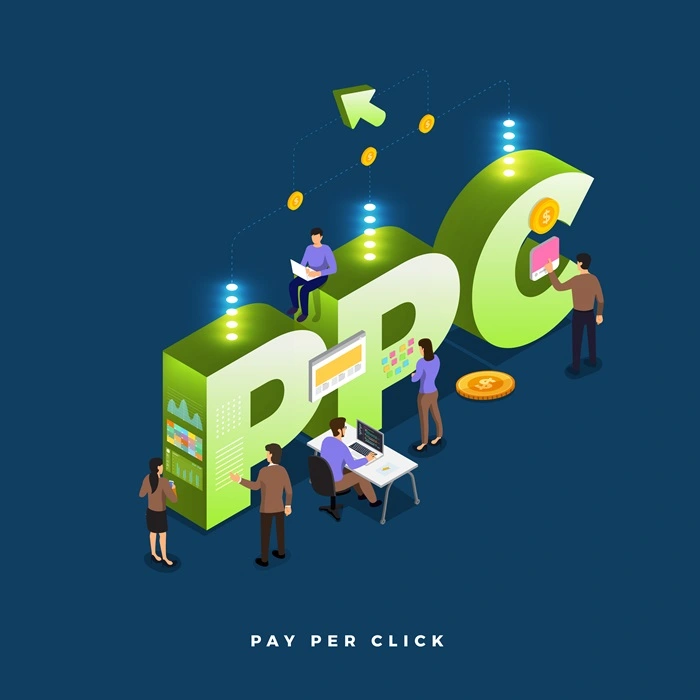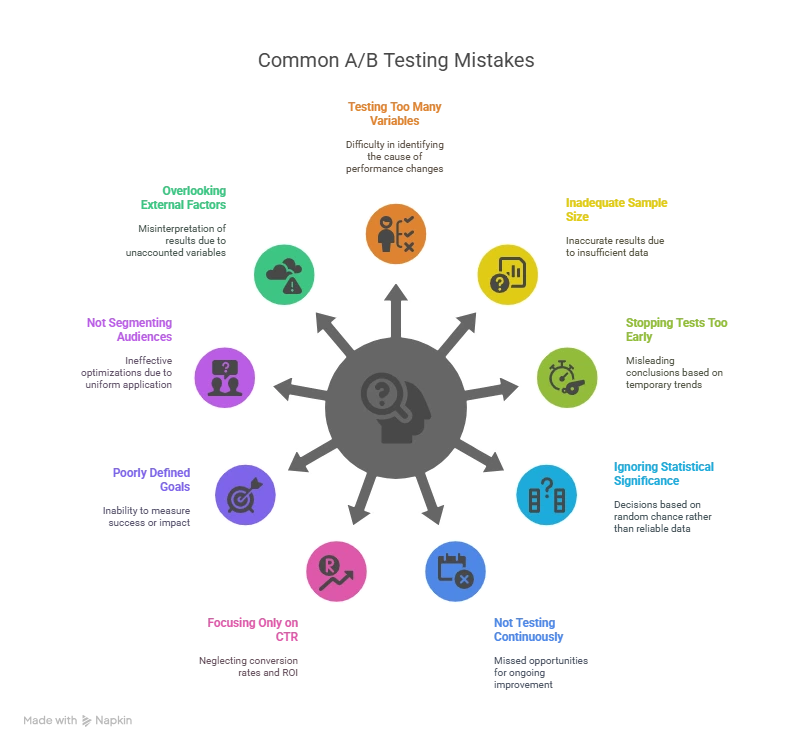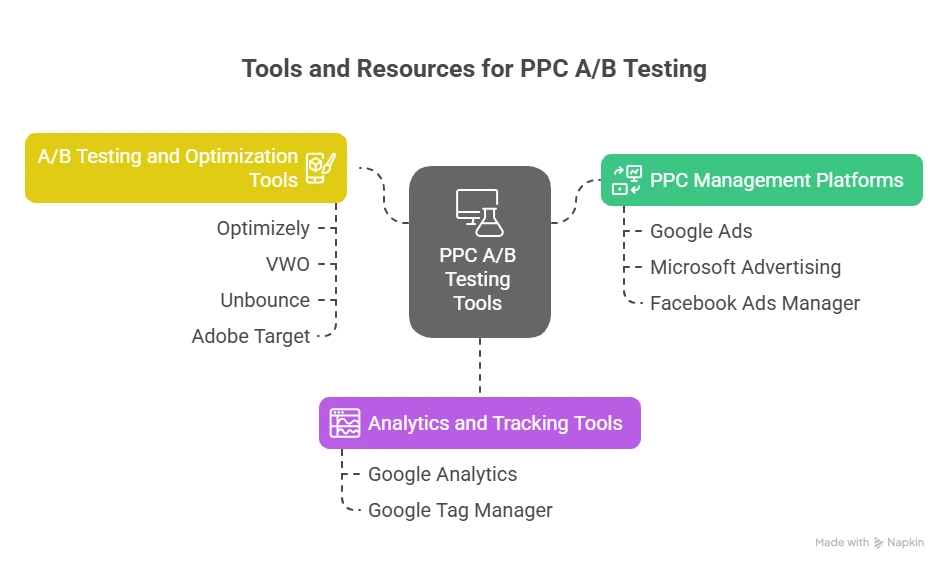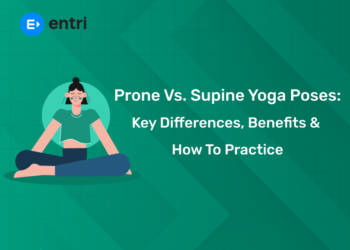Table of Contents
In the fast-paced world of Pay-Per-Click (PPC) advertising, where every click counts, marketers are always looking for ways to optimise campaigns and get the best return on investment (ROI). One of the best ways to improve PPC campaign performance is through A/B testing, also known as split testing.
A/B testing allows marketers to test different versions of their ads, landing pages, or keywords to see which one performs better. This is crucial for refining strategies, reducing cost,s and increasing conversions.
In this ultimate guide, we will go deep into what PPC A/B testing is, why it’s important for your campaigns, and how to do it right to get the best results. We’ll also cover the latest trends and techniques in A/B testing for PPC in 2025.
Key Takeaways:
- PPC A/B testing optimises ads, landing pages and keywords by comparing two versions to see which one performs better.
- It involves testing small changes like headlines, CTAs, images or even landing page elements to improve ad performance.
- Effective A/B testing can increase click-through rates (CTR), conversion rates (CR) and cost per click (CPC).
- Entri’s Digital Marketing Course teaches you in-depth PPC strategies including A/B testing and helps you become an expert in running optimised campaigns.
Learn Digital Marketing Fundamentals! Get Free Demo Here!
What is PPC A/B testing?
Pay-per-click (PPC) advertising has grown to be an important part of digital marketing plans for companies in a variety of sectors. Through these initiatives, marketers can increase website traffic that is specifically targeted and produce leads or purchases. But then managing effective PPC campaigns calls for more than just budgeting and producing eye-catching advertisements. And it’s critical to always improve and increase the performance of your ads, and PPC A/B Testing is a useful tool for achieving this.
- Ad performance can be improved and PPC campaigns optimized with the use of A/B testing.
- You can improve your advertising plan by gaining insightful knowledge about what appeals to your target audience by heeding the above-mentioned advice and techniques.
- As you test and learn, don’t forget to set goals, concentrate on one variable at a time, formulate hypotheses, do split tests, monitor metrics, iterate, and take user experience into account.
- You may increase the efficacy of your PPC campaign, get better results, and get more return on your advertising expenditure with regular testing and optimization.
Elements You Can A/B Test in Your PPC Campaigns
A/B testing, often known as “split testing,” is a sort of experiment where you make two or more versions of a piece of content, such as an email, landing page, or advertisement, and you show them to various audience segments to see which one works best. A/B testing essentially allows you to play scientist and make judgments based on information about real user behavior on your page.
The following are some essential components of your PPC campaigns that you can A/B test: PPC A/B testing is a critical technique for optimizing PPC (Pay-Per-Click) campaigns by determining what drives clicks and conversions the best:
 1. Adwords
1. Adwords
- Try a few different headlines to see which gets the most clicks and the greatest conversion rate.
- Try different body text versions to see which messages your audience responds to the best.
- See which CTAs (such as “Buy Now” vs. “Learn More”) encourage customers to click through and take action.
2. Advertising Types
- To determine which text ad format and location is most effective, compare many options.
- Try out different image or banner ads with varied copy and images.
- Try out various video durations, styles, and contents.
3. Key words
- Try out several match kinds to determine which produces the best outcomes in terms of cost and relevancy.
- Determine which negative keywords enhance ad effectiveness and help you fine-tune your targeting.
- Examine the relative merits of long-tail and short-tail keywords.
4. Techniques for Bidding
- Determine which bidding strategies, such as target CPA or target ROAS, produce better results: manual versus automated CPC bidding.
- Try varying the bid for various devices, locations, and times of day.
5. Homepages
- Test different landing page layouts, designs, and content combinations.
- Analyze the results of sending traffic to one landing page versus several that are customized for various market categories.
- Try varying the form’s lengths and fields to discover what maximizes conversion rates.
6. Extensions for Ads
- Test several sitelink destinations and messages.
- Try diverse callout texts to emphasize distinct selling features.
- To find the most interesting snippets, compare their headers and values.
- Examine the effects of varying product or service prices on click-through and conversion rates.
7. Choosing a Target
- Try ad campaigns aimed at several regions to determine which ones work best.
- Try focusing on various demographics, including age, gender, and income brackets.
- Analyze performance on various devices (tablet, smartphone, and desktop) to determine which platforms work best.
8. Ad Scheduling
- To determine the ideal ad schedule for your audience, try a variety of times of day and days of the week.
- Compare the outcomes of running the advertisements continuously vs within the selected time windows.
Learn Digital Marketing Fundamentals! Get Free Demo Here!
PPC Testing Methodologies
The PPC (Pay-Per-Click) testing methodologies refer to the various techniques and strategies used to assess and optimize the PPC advertising campaigns. These methodologies will help marketers to improve ad performance, increase ROI, and make data-driven decisions. Here are some of the common PPC testing methodologies:
1. A/B Testing (Split Testing)
- The objective is to determine which of the two ad versions (Ad A and Ad B) works better by changing just one element (such as the headline, CTA, or image).
- The goal is to identify the variation that produces the required metrics, like higher click-through rates (CTR) or conversions.
- Implementation: Run two advertisements at the same time, and then contrast the performance indicators.
2. Multivariate Testing
- The purpose of testing numerous variables at once within an advertisement or landing page is to determine how the various aspects interact with one another.
- Finding the ideal mix of the variables that produces the best outcomes is the goal.
- Implementation: Make several iterations of an advertisement or landing page using different element combinations, then examine performance information.
3. Bid Strategy Testing
- The purpose of bid strategy testing is to evaluate several bidding tactics in order to determine which one will best meet campaign objectives at the lowest possible cost.
- The goal is to determine the most effective bidding method (such as target CPA, automated bidding, and manual CPC) in order to maximize ad spend and increase return on investment.
- Implementation: To put the various bidding strategies into practice, compare the campaign results overall, as well as the cost per click and cost per conversion.
4. Audience Testing
- In order to determine which target audiences are most profitable and receptive, several audience segments are tested via audience testing.
- Goal: By identifying the audiences that convert the best, this strategy aims to enhance targeting and boost marketing effectiveness.
- Implementation: Make advertisements aimed at several audience subgroups, and thereafter examine the performance information for each.
Common PPC A/B Testing Mistakes
PPC A/B testing can be tricky and lead to tilted findings and incorrect strategy, even if it is very important for maximizing the ad performance. And testing too many variables at once is a typical mistake that makes it challenging to determine which change affected the result. Early conclusions can be drawn from insufficient sample sizes, and acting on temporary variations rather than reliable data is frequently the result of ending experiments too soon.
A/B testing is a crucial component of PPC (Pay-Per-Click) advertising optimization, but it must be executed correctly to yield meaningful results. Ignoring statistical significance may cause judgments to be made on the basis of conjecture rather than reliable data. Here are some common mistakes to avoid:
1. Testing Too Many Variables at Once
- Mistake: Changing multiple elements in the ad or landing pages simultaneously.
- Consequence: Is to makes it difficult to determine which change caused the improvement or decline in performance.
- Solution: Test one variable at a time to separate its impact on the performance.
2. Inadequate Sample Size
- Mistake: Is drawing conclusions from tests with insufficient data.
- Consequence: Leads to inaccurate results and then potentially misleading conclusions.
- Solution: Prior to making any judgments, make sure you have a sufficiently large sample size to attain statistical significance.
3. Stopping Tests Too Early
- Mistake: Ending the test as soon as one variation shows promising results.
- Consequence: early conclusions can lead to incorrect decisions based on the temporary variations.
- Solution: Extend the experiment long enough to take into consideration changes in the user behavior and the outside influences.
4. Ignoring Statistical Significance
- Mistake: Making decisions based on the results that aren’t statistically significant.
- Consequence: Risk of basing the decisions on random chance rather than reliable data.
- Solution: Before making any adjustments, make sure your results are trustworthy by using statistical significance calculators.
5. Not Testing Continuously
- Mistake: Conducting the A/B tests occasionally rather than as an ongoing process.
- Consequence: Missed opportunities for continuous improvement and optimization.
- Solution: Include A/B testing in the daily management of your PPC campaigns.
6. Focusing Only on CTR
- Mistake: Optimizing solely for click-through rates (CTR) without considering conversion rates or ROI.
- Consequence: High CTR doesn’t always translate to high conversion rates or profitability.
- Solution: Consider multiple metrics, including conversion rate, cost per acquisition (CPA), and return on ad spend (ROAS).
7. Poorly Defined Goals
- Mistake: Running tests without clear objectives or goals.
- Consequence: Inability to measure success or understand the impact of changes.
- Solution: Define specific, measurable goals for each A/B test (e.g., increase CTR by 10%, reduce CPA by 15%).
8. Not Segmenting Audiences
- Mistake: Running A/B tests without considering different audience segments.
- Consequence: Results may not apply uniformly across all user groups, leading to ineffective optimizations.
- Solution: Segment your audience and run tests for each segment to understand how different groups respond.
9. Overlooking External Factors
- Mistake: Ignoring external factors that could influence test results (e.g., seasonality, competitor actions).
- Consequence: Misinterpretation of results due to unaccounted variables.
- Solution: Consider and account for external factors when planning and analyzing A/B tests.
Learn Digital Marketing Fundamentals! Get Free Demo Here!
Tools and Resources for PPC A/B Testing
Entri App- Best Online Digital Marketing Course
New to PPC advertising and want to learn how to run A/B tests? Entri’s Digital Marketing Course is the place to start. The course covers everything PPC, including A/B testing, keyword management, ad creation, bid strategies, and analytics.
Entri’s Digital Marketing Course includes:
- Hands-on projects for real-world PPC campaigns.
- Expert guidance on tools like Google Ads, Facebook Ads, and Google Analytics.
- A deep dive into A/B testing techniques and how to optimise PPC campaigns for better results.
Conclusion
1: What is the primary goal of SEO (Search Engine Optimization)?
PPC A/B testing is a must-have in any digital marketing strategy. By testing and optimising your ads, landing pages, and keywords, you can increase your conversion rates, ROI, and overall ad performance.
With the right tools, mindset, and techniques, A/B testing can take your PPC campaigns to the next level. Whether you’re a beginner or an experienced marketer, continuous optimisation through A/B testing is key to staying competitive in today’s digital world.
Enrol in Entri’s Digital Marketing Course and get the skills and expertise to become proficient in PPC, A/B testing, and all things digital marketing. Get started today and refine your PPC strategies for 2025 and beyond!
Frequently Asked Questions
What is PPC A/B testing?
PPC A/B testing (or split testing) is the process of comparing two versions of a pay-per-click ad or landing page to determine which performs better based on metrics like click-through rate (CTR) or conversion rate.
Why is A/B testing important in PPC campaigns?
A/B testing helps optimise your ad spend by identifying which ad elements drive better results, reducing wasted budget and improving ROI.
What elements can I test in a PPC ad?
You can test headlines, descriptions, display URLs, ad extensions, CTAs, visuals (in display ads), and even landing pages.
How long should I run a PPC A/B test?
Run the test until you have enough data to reach statistical significance, usually a few days to a few weeks, depending on your traffic and budget.
Can I run multiple A/B tests at once?
It’s best to test one variable at a time to get clear, actionable insights. Running multiple tests simultaneously can lead to confusing results.
What tools can I use for PPC A/B testing?
Popular tools include Google Ads Experiments, Meta A/B Testing, VWO, Unbounce, and Optimizely.
What are common mistakes in PPC A/B testing?
Testing too many variables at once, ending tests too early, and failing to set clear goals or hypotheses are common pitfalls.
How often should I run A/B tests in PPC?
PPC A/B testing should be an ongoing process. Regular testing keeps your campaigns optimised and responsive to changes in audience behaviour and market trends.


![What is PPC AB Testing How to do it the Right Way [Updated 2025]](https://entri.app/blog/wp-content/uploads/2024/05/What-is-PPC-AB-Testing-How-to-do-it-the-Right-Way-Updated-2025-750x375.webp)
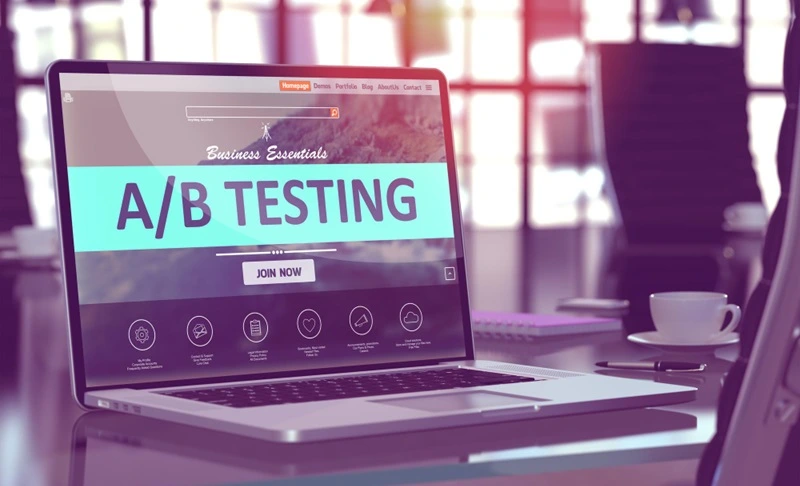
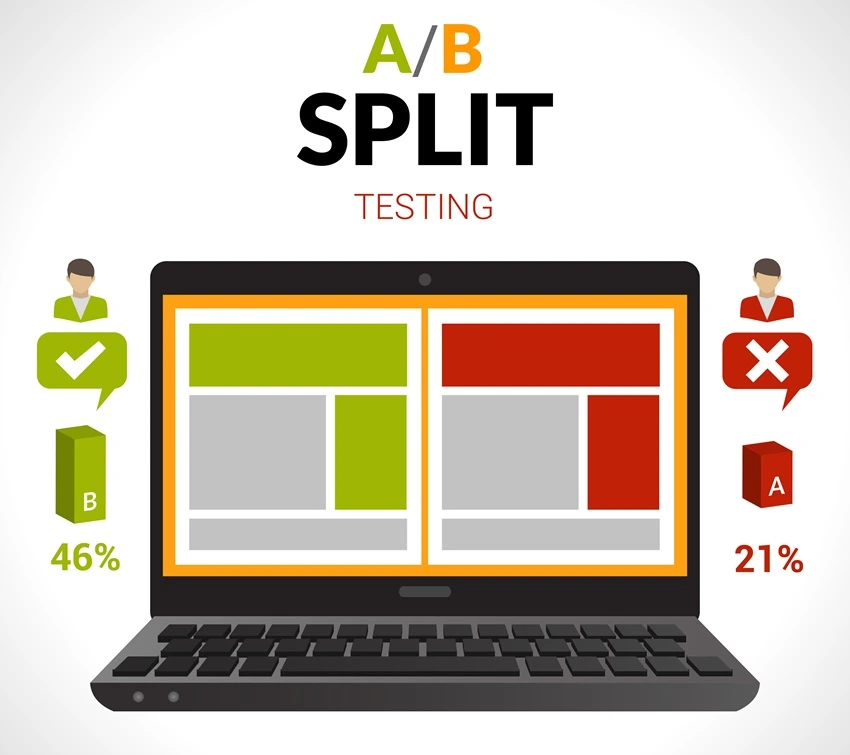
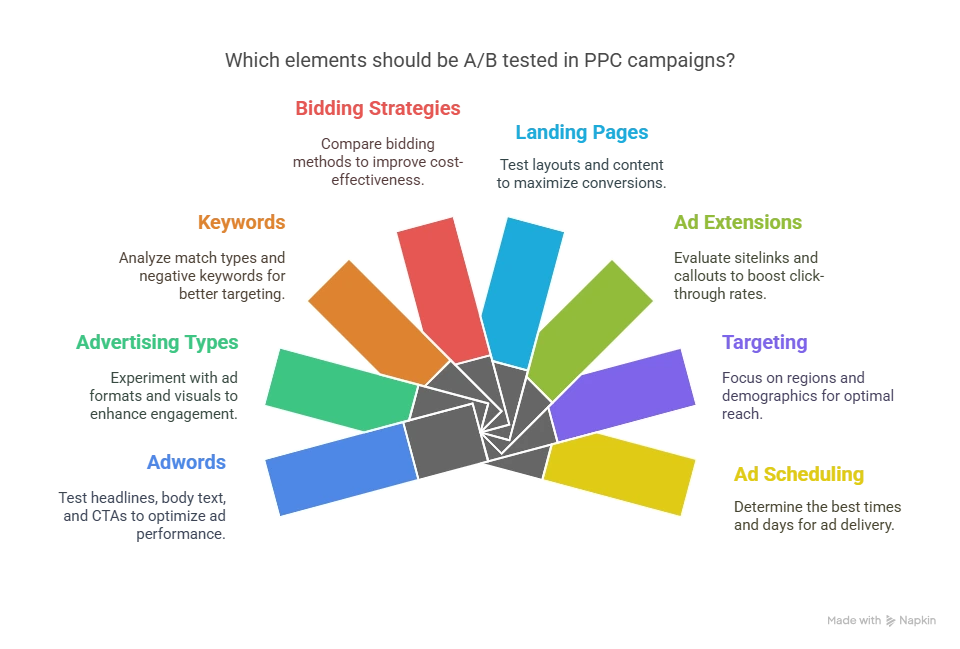 1. Adwords
1. Adwords